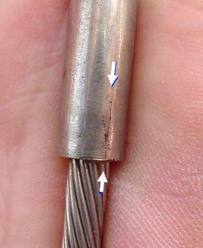ancora
Guru
- Joined
- Dec 16, 2007
- Messages
- 4,022
Our lifelines are 43 years old.
They are fine and never even thought of replacing them.
I read an anchor rode cable should be replace at times due to seawater corrosion but life lines are vinyl covered.
Our lifelines are 43 years old.
They are fine and never even thought of replacing them.
I read an anchor rode cable should be replace at times due to seawater corrosion but life lines are vinyl covered.
Our lifelines are 43 years old.
They are fine and never even thought of replacing them.
I read an anchor rode cable should be replace at times due to seawater corrosion but life lines are vinyl covered.
One post to that end Lou.
Many on this forum think catenary in the anchor rode is very important. Having an anchor shank high does awful things to the angle of the anchor fluke. If one has cable for a few feet the shank and a bit of cable slices into the seafloor fairly well. Notice the my thimble on the anchor end of the cable is vertical where it presents the least resistance to descending into the sea floor. But more importantly when the anchor shank tries to plunge into the bottom the cable presents far less drag than chain. Even small chain. So the shank goes deeper into the bottom.
Looking at Steve's Anchor Setting Vids one can see how the rode end of the anchor shank drops down to (and into the sea floor) if it can. This is advantageous.
One post to that end Lou.
Many on this forum think catenary in the anchor rode is very important. Having an anchor shank high does awful things to the angle of the anchor fluke. If one has cable for a few feet the shank and a bit of cable slices into the seafloor fairly well. Notice the my thimble on the anchor end of the cable is vertical where it presents the least resistance to descending into the sea floor. But more importantly when the anchor shank tries to plunge into the bottom the cable presents far less drag than chain. Even small chain. So the shank goes deeper into the bottom.
Looking at Steve's Anchor Setting Vids one can see how the rode end of the anchor shank drops down to (and into the sea floor) if it can. This is advantageous.
Our lifelines are 43 years old.
They are fine and never even thought of replacing them.
I read an anchor rode cable should be replace at times due to seawater corrosion but life lines are vinyl covered.




Eric, the white vinyl can hide rust damage in the cable. Back in my ill spent youth I flew wire braced hang gliders and landed them in salt water. Some of the cables were covered in clear vinyl and we often saw rust stains under the vinyl. Some cables were covered in white vinyl. When we stripped the vinyl we found broken wire strands. If we hadn't seen the rust through the clear vinyl, we would never have checked the white vinyl.
The fix was to go the next larger wire size without the vinyl covering. If I remember we went from 3/32" vinyl coated wire to 1/8" uncoated wire.
Eric,
Lifelines and Rigging has an excellent Inspection Checklist that provides inspection schedules and average lifespans of lifelines and rigging. Your vinyl-covered swaged lifelines are exactly what they address.
I've taken the liberty of including some photos from their site to illustrate this.



I have personally seen a 200 pound man working the foredeck of a sailboat go right through a lifeline as if it weren't even there. It was only 10 years old and was inspected before every race. We later found a hairline crack in a swaged terminal had let go. And, that is not the only time I have seen lifelines fail.
So, in addition to any rusted wire, clean and carefully inspect all of the swaged lifeline terminals and fittings.
Please take a look at the checklist and recommendations for guidance from rigging professionals. IMO, there is no room for guesswork or compromise when it comes to safety equipment, and you operate in cold water where this is doubly important.
OK, I'm climbing down from my soapbox now
Hi Larry,
Don’t have ANYTHING on our boat that looks even remotely like those pics. I do put some force on my life lines when doing things like turning off and on the propane that’s on the cabin top.



Interesting thread.
I always crewed other peoples sailboats. Never owned a big one myself.
I wonder if anyone does liquid penetrant inspection (LPI) on the swedges. I know, not a sailing forum, but would be a cheap and easy way to detect cracks and SCC.
Very interesting HC. I suspect you were into hang gliding very early on .. say mid 70’s .. as was I. I flew an old 18’ Chandelle standard that probably had coated wires. We needed the coating for all the crashing on the sand dunes. I flew that thing from 3000’ mountians before we found our they were divergent. Did lots of whip stalls but never got really straight down. I’ve come closer to death in Dixion Entrance near Ketchikan.
Parks I think I may have dreamt that up on my own but I’m very flattered to know Danforth had the same idea. To be of benefit the bottom needs to be soft enough to allow the shank to penetrate the bottom. But goodie for us most bottoms in northern lats are mud and in southern climes sand so w any significant penetration there should be benefit.
I just thought I could even improve on it by putting the thimble through the anchor shank hole and swage it on the cable. But the cable may twist or bind or both.
